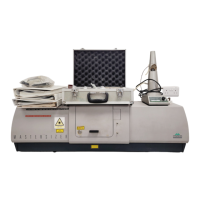ultrasonics by placing the slurry and its beaker into an ultrasonic bath. It will be
apparent if this has been effective. Further ultrasonics can be applied when the
sample is added to the tank, if necessary. This will often prevent
re-agglomeration, but is not always necessary.
%
Caution
Samples with unstable concentrations
When adding the sample to the tank using the measure-inspect facility of the
software you will occasionally experience obscurations that change during the
dispersion period. Most samples will disperse very quickly so you will not notice
the obscuration value rising. With some samples however the slow dispersion of
the sample can be clearly seen. A measurement should not be made until the
obscuration has stabilised - indicating that the sample has properly dispersed.
The obscuration and its behaviour during the dispersion of the sample can also
warn of other potential problems.
If the obscuration decreases then the size of the particles within the sample may
be increasing, either the sample is sticking together or the particles are actually
swelling due to the dispersant. Other causes could be the larger particles settling
out due to inadequate pumping and stirring or even the particles dissolving.
If the obscuration increases rapidly it could be that particles are attaching
themselves to the cell windows due to surface charges. The material is therefore
in the analyser beam continuously and the obscuration appears to increase. To
solve this problem use an appropriate admixture.
Bubbles
Bubbles have been mentioned earlier in this chapter. To the Mastersizer optics all
bubbles are seen as particles and are therefore measured. You should always be
wary of bubbles within the system.
Be wary of using ultrasonics with fragile particles as the ultrasonic action may
actually break up the particles themselves. If in any doubt, microscopic
observation before and after ultrasonics should establish whether it has been
beneficial or not.
CHAPTER 9
GETTING STARTED
Page 9.7

